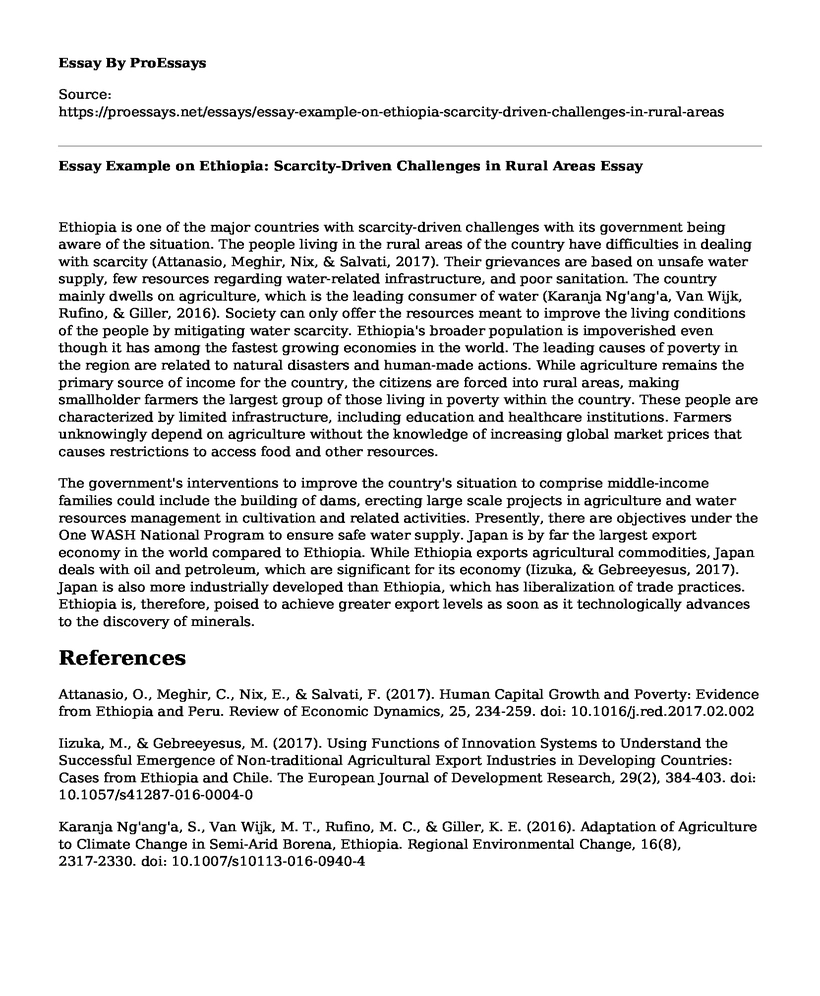Ethiopia is one of the major countries with scarcity-driven challenges with its government being aware of the situation. The people living in the rural areas of the country have difficulties in dealing with scarcity (Attanasio, Meghir, Nix, & Salvati, 2017). Their grievances are based on unsafe water supply, few resources regarding water-related infrastructure, and poor sanitation. The country mainly dwells on agriculture, which is the leading consumer of water (Karanja Ng'ang'a, Van Wijk, Rufino, & Giller, 2016). Society can only offer the resources meant to improve the living conditions of the people by mitigating water scarcity. Ethiopia's broader population is impoverished even though it has among the fastest growing economies in the world. The leading causes of poverty in the region are related to natural disasters and human-made actions. While agriculture remains the primary source of income for the country, the citizens are forced into rural areas, making smallholder farmers the largest group of those living in poverty within the country. These people are characterized by limited infrastructure, including education and healthcare institutions. Farmers unknowingly depend on agriculture without the knowledge of increasing global market prices that causes restrictions to access food and other resources.
The government's interventions to improve the country's situation to comprise middle-income families could include the building of dams, erecting large scale projects in agriculture and water resources management in cultivation and related activities. Presently, there are objectives under the One WASH National Program to ensure safe water supply. Japan is by far the largest export economy in the world compared to Ethiopia. While Ethiopia exports agricultural commodities, Japan deals with oil and petroleum, which are significant for its economy (Iizuka, & Gebreeyesus, 2017). Japan is also more industrially developed than Ethiopia, which has liberalization of trade practices. Ethiopia is, therefore, poised to achieve greater export levels as soon as it technologically advances to the discovery of minerals.
References
Attanasio, O., Meghir, C., Nix, E., & Salvati, F. (2017). Human Capital Growth and Poverty: Evidence from Ethiopia and Peru. Review of Economic Dynamics, 25, 234-259. doi: 10.1016/j.red.2017.02.002
Iizuka, M., & Gebreeyesus, M. (2017). Using Functions of Innovation Systems to Understand the Successful Emergence of Non-traditional Agricultural Export Industries in Developing Countries: Cases from Ethiopia and Chile. The European Journal of Development Research, 29(2), 384-403. doi: 10.1057/s41287-016-0004-0
Karanja Ng'ang'a, S., Van Wijk, M. T., Rufino, M. C., & Giller, K. E. (2016). Adaptation of Agriculture to Climate Change in Semi-Arid Borena, Ethiopia. Regional Environmental Change, 16(8), 2317-2330. doi: 10.1007/s10113-016-0940-4
Cite this page
Essay Example on Ethiopia: Scarcity-Driven Challenges in Rural Areas. (2023, Jan 27). Retrieved from https://proessays.net/essays/essay-example-on-ethiopia-scarcity-driven-challenges-in-rural-areas
If you are the original author of this essay and no longer wish to have it published on the ProEssays website, please click below to request its removal:
- Reflective Essay on My Experience With Social Media Addiction
- African Musical Elements and American Musical Culture
- Feminism Annotated Bibliography
- Cultural Perception & Gendered Interpretation: A Communication Obstacle - Essay Sample
- Comparison of the US Constitution and the Articles of Confederation Essay
- Progressivism: Social Reform to Improve Lives - Essay Sample
- Paper Example on 20th Century Literature Theory: Reflection of Social Conditions







